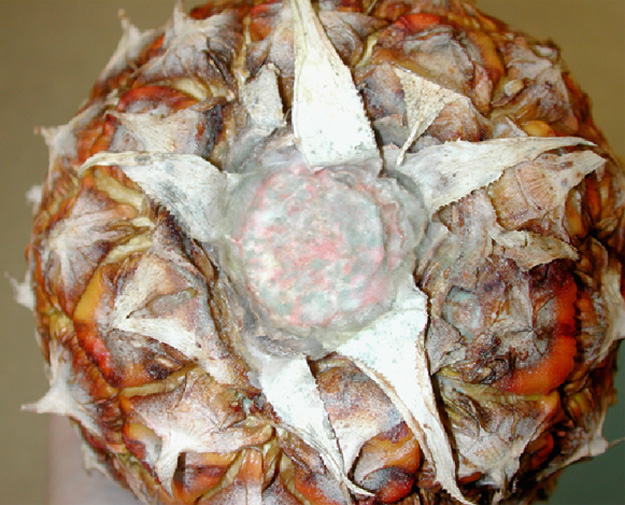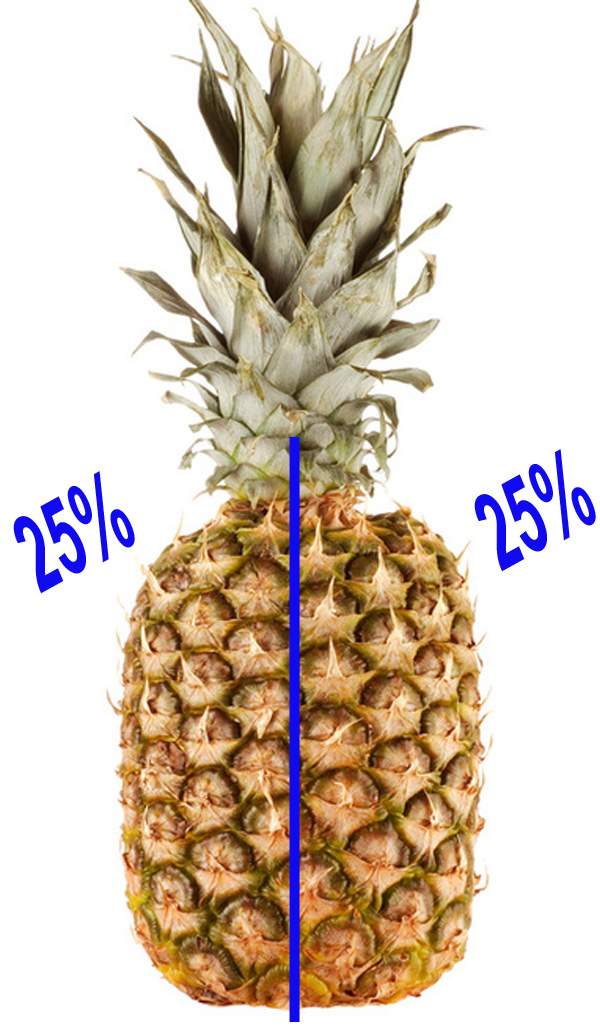Every now and then we come across a defect, assume we know how it should be scored and then find ourselves surprised when we discover the USDA has a very different scoring guideline. How about the defect, “surface mold” on pineapples? We commonly find mold affecting pineapples, usually around the base, or the cut stem end. It may be white, sometimes showing hints of gray or even blue. Most people (including myself) would score the pineapple as a defect if the mold was readily noticeable.

Looking at the image above, would you score this pineapple as a defect? Let’s see…..do you think it materially affects the appearance of the pineapple? If you were in a grocery store and noticed this pineapple, would you buy it? Would you look for another pineapple without the mold? If you answered “yes” to these questions then you should score this pineapple as a defect, on the general scoring guidelines for damage and serious damage. But the USDA has their own opinion. The following comes from their Inspection Instruction Manual for Pineapples:
Mold growth will usually not be a factor if the pineapples are stored properly. However, on occasion, a white to gray mold growth will form on the tops, and/or fruit. Mold growth on the fruit can be on the shell or at the cut stem end. Even though the mold does not affect the flesh, it may appear objectionable. If mold growth is objectionable, use the following as a guide; score as damage when more than 25% of the surface is affected and as serious damage when more than 50% of the surface is affected.
Do you agree with their guideline…..only score as a defect when the mold is objectionable AND is affecting more than 25% of the surface?
The mold would have to affect an area greater than 25% of the surface, not just 25% of the stem or bottom area. In the image above you can see one side of the pineapple, or 50% of its surface. If we divide the side in half, we can see how much of a surface area 25% is. Based on the USDA’s scoring guideline for surface mold, the pineapple shown at the top would not be scored as a defect.
Any thoughts?


6 Comments on “Pineapples- Surface Mold”
1st off let me say that pineapples are not native to the united states so it is only natural for people to freak out at the 1st sign of mold on many fruits and vegetables. The USDA does its best to protect consumers and that usually involves over reacting to many things. The mold on the pineapple is not that big of an issue, the majority of people will not get sic from it. cutting the bottom off is completely fine. In fact you can actually use the moldy skin to make pineapple beer…which I have made many times.
Thank you for this. I have thrown out several pineapples thinking we might get sick from the mold. All mold was confined to the very bottom around the cut area. Now I can get back to the business of saving money by not discarding my delicious fruit.
That’s actually a ripe pineapple. A bit like bananas being more black than yellow when they are ready. I ate so many mouldy pineapples, they taste the best. People freak out way too much about produce looks, no wonder half goes to waste…
I just got out of the hospital after becoming very sick after eating a pineapple that had mold on the top. I cut that part off and only ate two slices from the middle of the pineapple. It smelled mildly fermented but tasted sweet. There was no mold visible. But I realized twelve hours later when I couldn’t stop vomiting that I had forgotten to rinse any mold off the knife. I have a chronic illness that must have made me more sensitive and am on a pain management for degenerative spine disease, so after I couldnt keep my pain meds down and threw up after just a few tiny sips of water I started experiencing compounding effects from withdrawal from my meds. And the pain became so unbearable I needed to go to the er – needles to say I’ll never eat a moldy pineapple again.
I find it interesting that the FDA would allow this much of the fruit to be rotten. I just bought a big P and it tasted like mold inside. The outside was not mold colored or smell. When will we get enough of this haphazard way of protection from a clearly fractured Gov. Any ideas?
If the pineapple has mold on the stem end, hold the leaves with a napkin and wash away the moldy stem/base of the pineapple. Squeeze the juice of a lime or lemon on the cleaned stem/base and pat dry the entire pineapple. Then lay the pineapple on its side and slice off about 3/4” to 1 inch from the stem/base and discard.. Continue carving the rest of pineapple by slicing off 3/4” to 1 inch at the leaves end. Finish slicing the standing pineapple around the tough core and cut into chunks for easy eating. Bon apetite.